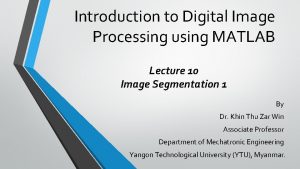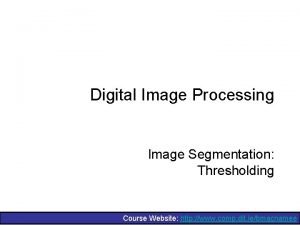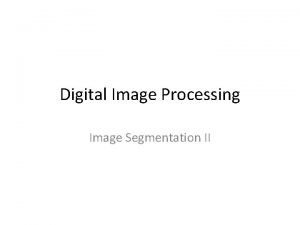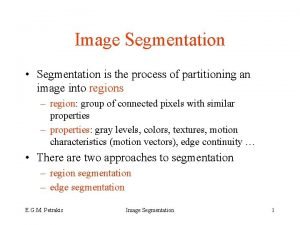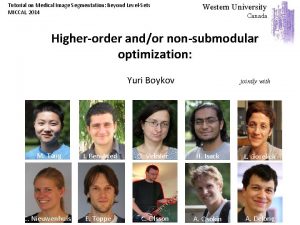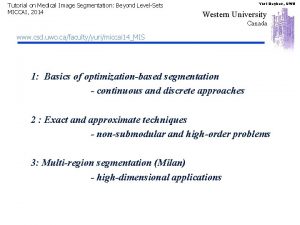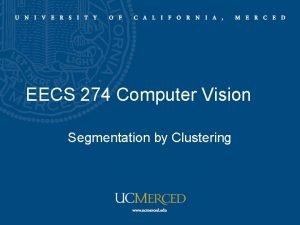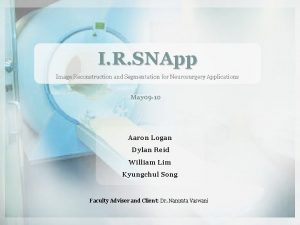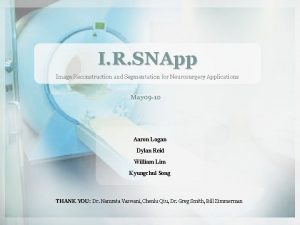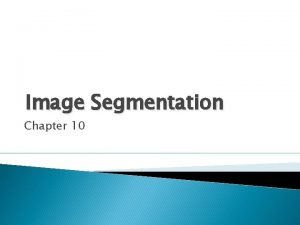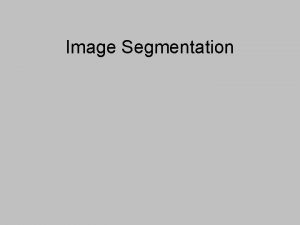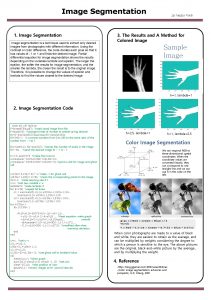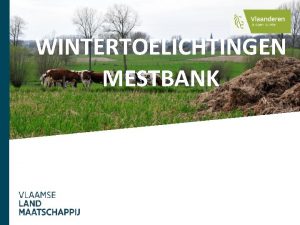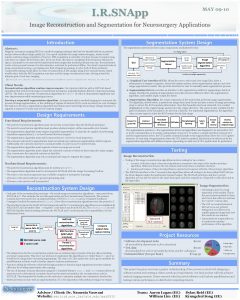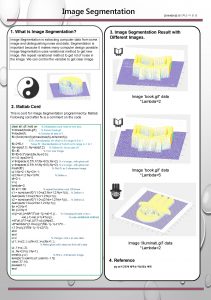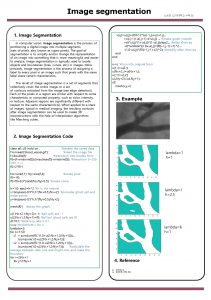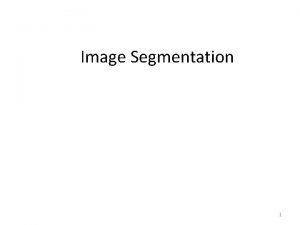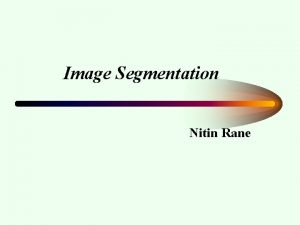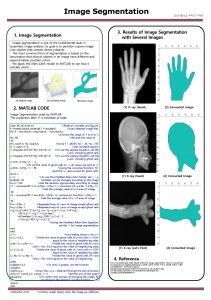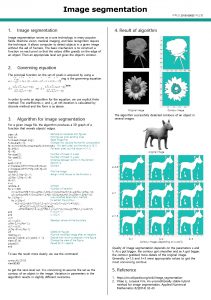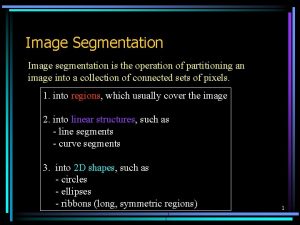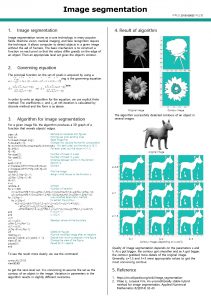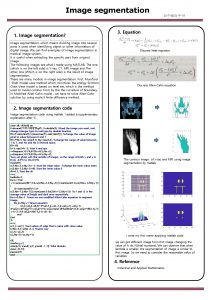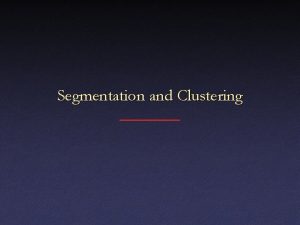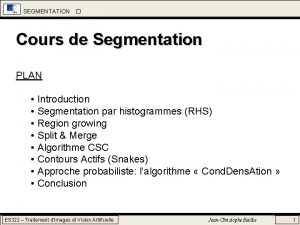I R SNApp Image Reconstruction and Segmentation for


















































- Slides: 50

I. R. SNApp Image Reconstruction and Segmentation for Neurosurgery Applications May 09 -10 Aaron Logan Dylan Reid William Lim Kyungchul Song THANK YOU: Dr. Namrata Vaswani, Chenlu Qiu, Dr. Greg Smith, Bill Zimmerman

Project Planning © 2008, I. R. SNApp – all rights reserved. 2

Problem Statement & Client Needs q Problem: need real-time MRI m Current MRI is slow: many measurements Ø Slow acquisition (10’s of minutes scan time) Ø Slow reconstruction (Fourier/k-space spatial domain) m Slow and inefficient segmentation (image analysis) algorithms q Solution/ Client Needs: m MR image reconstruction algorithm using Compressed Sensing Ø New technique in statistical signal processing/ estimation theory Ø Permits signal estimation using fewer observations/ measurements – Result is faster acquisition & less computation faster image reconstruction Ø Goal is real-time m Develop algorithm for sequential image segmentation Ø Sequentially segment deforming objects or ROI's from images Ø Utilize prior knowledge about shape change dynamics to segment noisy/low contrast imagery. Use only current and past images. Ø Goal is real-time © 2008, I. R. SNApp – all rights reserved. 3

Requirements Specification System Description & Diagrams q High-Level System Block Diagram Raw MR data Image Reconstruction Reconstructed MR image Image Segmentation © 2008, I. R. SNApp – all rights reserved. Reconstructed & segmented MR image 4

Requirements Specification System Description & Diagrams q Image Reconstruction Block Diagrams KFCS LSCS © 2008, I. R. SNApp – all rights reserved. 5

Requirements Specification System Description & Diagrams q Image Segmentation Block Diagram Reconstructed MR Image Manual ROI Selection – Algorithm Seed MATLAB Segmentation Code © 2008, I. R. SNApp – all rights reserved. Reconstructed & segmented Additional MR image Manual Tracing 6

Requirements Specification System Description & Diagrams q System GUI Sketches © 2008, I. R. SNApp – all rights reserved. 7

Requirements Specification Operating Environment & User Interface q Operating Environment m High-performance computing Ø Lots of memory Ø High speed Ø Future work on this project may require parallel processing Ø Linux application servers meet these requirements m User interacts with algorithm primarily through scripts and command line interfaces q User Interface m Command prompt windows Ø MATLAB command window Ø SSH access to Linux applications servers m Simple GUI for segmentation Ø User input to choose ROI location to seed algorithm Ø Allow user to select options Ø Visual image processing feedback © 2008, I. R. SNApp – all rights reserved. 8

Requirements Specification Project Requirements q Functional Requirements m FR-1: Algorithms shall output correct data. m FR-2: Ported version of reconstruction algorithm shall run significantly faster than MATLAB prototype version. m FR-3: The entire image processing program shall be capable of realtime execution. q Non-functional Requirements m NFR-1: The reconstruction program shall be written in C/C++. m NFR-2: The segmentation program shall be written in MATLAB. m NFR-3: The program shall employ parallel processing. m NFR-4: The source code shall be well documented. © 2008, I. R. SNApp – all rights reserved. 9

Requirements Specification Deliverables q A complete software system that 1. 2. 3. m takes raw MRI data, reconstructs the data into images, and performs segmentation on those images. Attributes of the system: Ø C/C++ code, well documented and working Ø Executable version of the code (MEX) Ø A basic GUI to assist segmentation process q Comprehensive test results © 2008, I. R. SNApp – all rights reserved. 10

Project Plan © 2008, I. R. SNApp – all rights reserved. 11

Project Plan Resource Requirements q C/C++ IDE and compiler q MATLAB installed with m Image Processing Toolbox m Other Toolboxes as necessary q GUI development environment m MATLAB/ GUIDE? m Visual Studio? m Eclipse with add-ons? q Test data m Raw MR data and corresponding images © 2008, I. R. SNApp – all rights reserved. 12

Project Plan Risks q Segmentation m Very data-dependent Ø Image contrast, focus/resolution of objects, etc. influence final results Ø Mitigated with good image preprocessing – Contrast correction/normalization, filtering m “Good” segmentation algorithm difficult to define objectively q Reconstruction m KFCS algorithm could cause PCs to crash, resulting in data loss Ø Eliminated by testing only small images on PCs for framework testing; performing batch tests on full-size images on Linux clusters q Raw data acquisition m “Raw” MRI data only exists internal to the machine m HIPAA privacy laws may pose issue with acquisition © 2008, I. R. SNApp – all rights reserved. 13

Project Plan Work Breakdown & Schedule q Image Reconstruction: m Aaron Logan, William Lim q Image Segmentation: m Kyungchul Song, Dylan Reid Understand Problem and Project Scope Understand Theory Learn Operating Environment Concept Testing Thanksgiving Break Algorithm Development – Modules Winter Break Algorithm Development – Integration Test Algorithm Framework Learning Design and Implementation Testing Breaks Test Algorithm for Robustness and Correctness Spring Break Miscellaneous Wrap-Up Tasks © 2008, I. R. SNApp – all rights reserved. 14

Design Project © 2008, I. R. SNApp – all rights reserved. 15

Design Approach q Image Reconstruction m Specifications are determined with two goals in mind: Ø Runtime improvements Ø Use good programming style and documentation q Image segmentation: research-oriented m Experimentation with IPT functions m See what yields good segmentation results © 2008, I. R. SNApp – all rights reserved. 16

System Design Image Reconstruction © 2008, I. R. SNApp – all rights reserved. 17

System Design – Reconstruction System Requirements q Port: MATLAB C q Faster m MATLAB prototype: ~6 minutes per 64 x 64 frame Ø (Chenlu Qiu’s PC) m Initial requirement: 3 x faster q Identical output © 2008, I. R. SNApp – all rights reserved. 18

System Design – Reconstruction Functional Decomposition & System Analysis q Implement KFCS Reconstruction © 2008, I. R. SNApp – all rights reserved. 19

Engineering Specification Image Reconstruction © 2008, I. R. SNApp – all rights reserved. 20

Engineering Specification – Reconstruction Input / Output Specifications q Inputs m MR k-space (Fourier-domain measurement) data Ø Data file m Process control parameters Ø Passed to program either as input parameters or as. INI file. Ø Observation percentage Ø Others? m Input / output options and directory information q Outputs m An array representation of image Ø Primary output format, passed to image segmentation system m Uncompressed image file -. BMP Ø Optional: for visual inspection by user © 2008, I. R. SNApp – all rights reserved. 21

Engineering Specification – Reconstruction User Interface Specification q Command line interfaces m Little return on investment for creating GUI Ø Research project! Ø Focus our time on client’s needs m Simplest interface to use for operating on Linux server connection © 2008, I. R. SNApp – all rights reserved. 22

Engineering Specification – Reconstruction Hardware Specification q Small scale testing m PCs in 2046 Coover: m CPU: Intel® Pentium® D, 3. 00 GHz m RAM: 2. 00 GB @ 2. 99 GHz q Large scale testing m ECp. E Linux application servers © 2008, I. R. SNApp – all rights reserved. 23

Engineering Specification – Reconstruction Software Specification q Language m C, not C++ Ø Compiles smaller than C++ Ø Runs faster – no overhead for OOP Ø Easier to learn; simple, yet powerful q Compiler m Min. GW (Minimalist GNU for Windows) distribution of GCC (GNU Compiler Collection) Ø Implements ANSI-C 99 standard – support for complex numbers Ø Behaves identically to most common C compilers on UNIX systems – Code compiled for PCs and Linux will behave very similarly © 2008, I. R. SNApp – all rights reserved. 24

Engineering Specification – Reconstruction Software Specification q Libraries m CLAPACK (C Linear Algebra Package) m FFTW (Fast C implementation of Fourier Transform) m Discrete Wavelet Transform package Ø Still looking for a C library that can do this. Part of ongoing research q Good style m Good abstraction practices Ø Happy medium between huge, complicated functions & too many small functions that bog down performance m No compiler warnings © 2008, I. R. SNApp – all rights reserved. 25

Engineering Specification – Reconstruction Software Specification q Documentation m Function header comments /* * Function name * Thorough description of function * List of input arguments * Output * Revision History * Author & date */ m In-context explanations & clarifications y = x^2; // x squared © 2008, I. R. SNApp – all rights reserved. 26

Engineering Specification – Reconstruction Test Specification q Automated test scripts m Generate / read program input m Run C and MATLAB algorithms in succession on same input m Compare output of each algorithm by differencing m Compute statistics on differences m Scripts written in MATLAB; access C algorithms through MEX (MATLAB executable) files © 2008, I. R. SNApp – all rights reserved. 27

Engineering Specification – Reconstruction Prototyping q runsim: MATLAB reconstruction simulation m Generates test data by taking FFT of image set Ø 32 x 32 images – manageable size for testing on PC m Tests different reconstruction techniques and looks at error, runtime of each Ø Kalman Filtering Ø Compressed Sensing, without deletions Ø Full Compressed Sensing (with deletions) Ø Genie-Aided Kalman Filtering m Full compressed sensing yielded best results m Full simulation on 1. 5 GHz PC took roughly 25 minutes Ø 6 minutes for full KFCS © 2008, I. R. SNApp – all rights reserved. 28

System Design Image Segmentation

System Design – Segmentation System Requirements q Develop segmentation algorithm in MATLAB q Achieve a contour that is correct m Includes only the ROI, no extraneous / artifact regions © 2008, I. R. SNApp – all rights reserved. 30

System Design – Segmentation System Requirements q Achieve a contour that is correct (cont. ) m Correct by visual inspection m Good contour with fine width, fine precision Ø ~1 pixel width (8 -connected) right wrong q Runtime upper bound: 1 sec/frame © 2008, I. R. SNApp – all rights reserved. 31

System Design – Segmentation System Analysis q Input: MR images of brain or other organ of interest q Automatically segments images q Goal of segmentation: m Simplify and change the representation of an image into something that is more meaningful and easier to analyze m Extract exact location of regions of interest within image q Output: the segmented MR image © 2008, I. R. SNApp – all rights reserved. 32

System Design – Segmentation Functional Decomposition Outputs: Display montage of original images Expanded on Next Slide Input: MR images Contour extraction Draw contour on original image Save segmented image in DICOM format Increment i until i = no. input images Display montage of segmented images Text file of generated files and image run info © 2008, I. R. SNApp – all rights reserved. 33

System Design – Segmentation Functional Decomposition Contour Extraction Read ith image Threshold (convert to B/W) Fill interior gaps Detect edges Smooth the object Dilate the image Output the contour of object © 2008, I. R. SNApp – all rights reserved. 34

Engineering Specification Image Segmentation © 2008, I. R. SNApp – all rights reserved. 35

Engineering Specification – Segmentation Input / Output Specification q Input: m MR Image sequence Ø File format: DICOM (Digital Imaging and Communications in Medicine)* Ø Size: 256 × 256 pixels* *NOTE: not limited to these Ø Grayscale m Directory information m Indices of images to process q Output: m MATLAB display: Ø the current segmented image Ø Display montage of the original and segmented images Ø a list of the image files that have been segmented m File output: Ø DICOM file of segmented image (original + contours overlaid) Ø CSV file of the contour pixel coordinates Ø Text file listing all the image files created, and execution results. © 2008, I. R. SNApp – all rights reserved. 36

Engineering Specification – Segmentation User Interface Specification q MATLAB Command Window q Segmentation GUI m File list, current segmented image, montages of original/ segmented images m Run and stop buttons; pertinent menu bar items m Prompts user with multiple dialog boxes Ø Input & Output Directories Ø Segmentation options © 2008, I. R. SNApp – all rights reserved. 37

Engineering Specification – Segmentation Hardware and Software Specification q Hardware Specification m Must achieve 1 sec/frame with the following: Ø CPU: Intel® Pentium® D, 3. 00 GHz Ø RAM: 2. 00 GB @ 2. 99 GHz Ø PCs in 2046 Coover meet this spec q Software Specification m MATLAB Version 7. 6 (R 2008 a) m Image Processing Toolbox, Version 6. 1 m Others: discussed for reconstruction Ø Documentation practices Ø Good data abstraction Ø No MATLAB Interpreter warnings © 2008, I. R. SNApp – all rights reserved. 38

Engineering Specification – Segmentation Test Specification q Visual inspection of output contour m Simple and most robust method of checking that output meets requirements q Speed (throughput time) of the system m Measured using the timing functions available with MATLAB Ø tic and toc stopwatch functions Ø clock Ø MATLAB Profiler © 2008, I. R. SNApp – all rights reserved. 39

Engineering Specification – Segmentation Prototype Segmentation Algorithm (1/8) q Step 1: Read Image m Original image m dicomread © 2008, I. R. SNApp – all rights reserved. 40

Engineering Specification – Segmentation Prototype Segmentation Algorithm (2/8) q Step 2: Threshold Image m Threshold the grayscale image to black and white m im 2 bw © 2008, I. R. SNApp – all rights reserved. 41

Engineering Specification – Segmentation Prototype Segmentation Algorithm (3/8) q Step 3: Edge Detection m Detect the edges with binary gradient mask m edge, sobel m Does not yield a good contour Ø need the next steps to improve © 2008, I. R. SNApp – all rights reserved. 42

Engineering Specification – Segmentation Prototype Segmentation Algorithm (4/8) q Step 4: Image Contour Dilation m Dilate the objects in the image using dilated gradient mask m imdilate, strel © 2008, I. R. SNApp – all rights reserved. 43

Engineering Specification – Segmentation Prototype Segmentation Algorithm (5/8) q Step 5: Hole Filling m Holes within objects are filled m imfill © 2008, I. R. SNApp – all rights reserved. 44

Engineering Specification – Segmentation Prototype Segmentation Algorithm (6/8) q Step 6: Object Boundary Smoothening by Erosion m Smoothen the white pixel boundaries using erosion m imerode, strel © 2008, I. R. SNApp – all rights reserved. 45

Engineering Specification – Segmentation Prototype Segmentation Algorithm (7/8) q Step 7: Extraction of Contours m Extract the contour pixels from the object boundaries m bwperim © 2008, I. R. SNApp – all rights reserved. 46

Engineering Specification – Segmentation Prototype Segmentation Algorithm (8/8) q Step 8: Final Segmented Image m Overlay extracted contours on original image © 2008, I. R. SNApp – all rights reserved. 47

Project Design Summary q Implementation already in progress q Project risks: all can be eliminated or mitigated q Project feasibility m Low cost – all resources, except for test data, already available m Test data could be obtained as part of research agreement q Project success would help advance field of medical imaging m Project has been scoped well within our means © 2008, I. R. SNApp – all rights reserved. 48

Questions and Discussion © 2008, I. R. SNApp – all rights reserved. 49

Wrap-up q Required and requested changes q Action items © 2008, I. R. SNApp – all rights reserved. 50
 Joanne snapp
Joanne snapp Image segmentation in digital image processing
Image segmentation in digital image processing Segmentation in digital image processing
Segmentation in digital image processing Segmentation in digital image processing
Segmentation in digital image processing Image segmentation course
Image segmentation course Filteration
Filteration Portrait matting
Portrait matting Image partitioning
Image partitioning Medical image segmentation tutorial
Medical image segmentation tutorial Medical image segmentation tutorial
Medical image segmentation tutorial Amplitude
Amplitude Oliver van kaick
Oliver van kaick Image segmentation
Image segmentation Analog image and digital image
Analog image and digital image Fspos vägledning för kontinuitetshantering
Fspos vägledning för kontinuitetshantering Typiska drag för en novell
Typiska drag för en novell Tack för att ni lyssnade bild
Tack för att ni lyssnade bild Vad står k.r.å.k.a.n för
Vad står k.r.å.k.a.n för Shingelfrisyren
Shingelfrisyren En lathund för arbete med kontinuitetshantering
En lathund för arbete med kontinuitetshantering Underlag för särskild löneskatt på pensionskostnader
Underlag för särskild löneskatt på pensionskostnader Personlig tidbok
Personlig tidbok A gastrica
A gastrica Förklara densitet för barn
Förklara densitet för barn Datorkunskap för nybörjare
Datorkunskap för nybörjare Tack för att ni lyssnade bild
Tack för att ni lyssnade bild Debatt artikel mall
Debatt artikel mall Delegerande ledarstil
Delegerande ledarstil Nyckelkompetenser för livslångt lärande
Nyckelkompetenser för livslångt lärande Påbyggnader för flakfordon
Påbyggnader för flakfordon Vätsketryck formel
Vätsketryck formel Svenskt ramverk för digital samverkan
Svenskt ramverk för digital samverkan Jag har nigit för nymånens skära
Jag har nigit för nymånens skära Presentera för publik crossboss
Presentera för publik crossboss Argument för teckenspråk som minoritetsspråk
Argument för teckenspråk som minoritetsspråk Bat mitza
Bat mitza Treserva lathund
Treserva lathund Mjälthilus
Mjälthilus Bästa kameran för astrofoto
Bästa kameran för astrofoto Centrum för kunskap och säkerhet
Centrum för kunskap och säkerhet Verifikationsplan
Verifikationsplan Mat för idrottare
Mat för idrottare Verktyg för automatisering av utbetalningar
Verktyg för automatisering av utbetalningar Rutin för avvikelsehantering
Rutin för avvikelsehantering Smärtskolan kunskap för livet
Smärtskolan kunskap för livet Ministerstyre för och nackdelar
Ministerstyre för och nackdelar Tack för att ni har lyssnat
Tack för att ni har lyssnat Vad är referatmarkeringar
Vad är referatmarkeringar Redogör för vad psykologi är
Redogör för vad psykologi är Stål för stötfångarsystem
Stål för stötfångarsystem Atmosfr
Atmosfr


